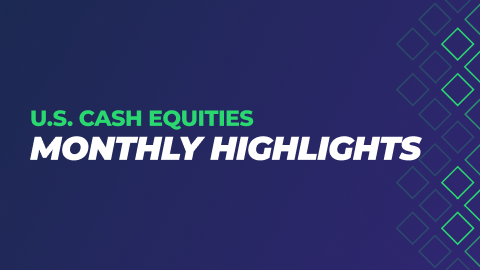
Read More
When we notice a new trading trend, we look for ways that we can improve our exchanges to better fit the way our customers use them. As closing auctions become an increasingly important part of the trading day, we wanted to uncover ways to enhance end-of-the-day trading for market participants. In our latest analysis, we explore how closing auction events impact volumes, and share how upcoming changes to the close on Cboe’s BZX exchange may benefit participants.
The opening and closing prints typically make up the largest individual trades for the day, and trading near the close has steadily gained more popularity over time. In October the closing auction made up about 4.5% of total market volume, as seen in Figure 1 below. But how do closing auction events impact these volumes?
Figure 1 Auction Percentage of Total Volume1
To prepare for the closing auctions, listing exchanges follow a specific timeline of events leading up to the auction print. Here’s a guide to closing auction events and the times at which these events occur across the listing markets.
Figure 2 Closing Auction Key Events
Each event has its own significance, which is reflected in the volume curves for each market. In order to analyze trading volumes going into the close, we studied the most liquid securities on each listing venue. For Nasdaq and NYSE, we looked at all S&P 500 single stock names that are either NYSE or Nasdaq listed securities, respectively. For Cboe BZX and NYSE Arca, we calculated a 21-day moving average of total volume to find the top 10 most liquid ETFs on each exchange.
In order to show the nature of volumes heading into the close, we zoomed in on trading during the last 30 minutes of the last 21 trading days. We found that volume trends across the four listing markets analyzed are very similar and react to many of the same events. It is important to note the key times and events during the closing auction, since cutoffs and imbalance dissemination vary by listing exchange.
Figure 3 depicts the percent of total volume from 3:30 p.m. to 4 p.m. on each listing exchange and shows there are significant upticks in volume during the closing auction events on each exchange. The events listed in Figure 2 above, drive the percentage of total volume for all listing exchanges to increase up until the final seconds of the trading day. During that time, each exchange experiences a spike in volume almost five times greater than continuous trading volumes throughout the rest of the regular trading session.
Figure 3 Percentage of Total Volume by Minute5
In addition to studying closing volume trends, we found it important to analyze a transaction rate calculated as the amount of transactions per second on each listing exchange. We took a simple average of total transactions on each exchange over the same 21-day trading period used before. As you can see in Figure 4, we found the increase in transactions per second around key closing auction events was similar to the increase in total volume. At 3:50pm, there is a 50–75% increase in transactions per second. The transaction rate continues to steadily increase until the final minutes of the day. When exchanges stop accepting orders and allowing order cancels, the transaction rate returns to the same elevated levels and the closing auction begins.
Figure 4 Transaction Rate Per Second6
Our findings emphasize the importance of the closing auction and the continuous session period right before the auction. Although auctions are considered outsized trading events, we found that there is typically a large amount of liquidity available near the close during the continuous session. The transaction rate spikes seen at the end of the day are also associated with the narrowest quoted spreads of the day, as shown in Figure 5 below. To determine this, we took the average basis point spread by minute for all names in the S&P 500. Spreads throughout the day are downward sloping and are typically widest at the open, as they continue to decrease until the close. However, there is usually a small increase in spreads at 3:50 p.m., when an important closing auction event occurs.
Figure 5 S&P 500 Average Spreads per Minute7
The increased level of information available near the close, due to the events described above, equips market participants to make more informed trading decisions. This increased information is also associated with higher urgency since the continuous session is near its end. This urgency makes it critically important for market participants to pick venues that have faster transaction rates. In a past note, we highlighted how EDGX provides faster fills and transaction rates than its peer exchanges.8
In this type of environment, trading flexibility is key, which is why Cboe plans to propose changes to the BZX close time cutoffs to allow participants to benefit from the higher volume and added information seen pre-close. By doing so, participants may also benefit from the increased liquidity environment, without having to commit quantity to the closing print.
Contact your Cboe Global Markets coverage team to learn more about how these changes may help you enhance your execution.
Footnotes 1, 5, 6, 7 Source: Cboe Market Data
2020 Cboe Exchange, Inc. All rights reserved.
The information in this letter is provided for general education and information purposes only. No statement(s) within this letter should be construed as a recommendation to buy or sell a security or to provide investment advice. Supporting documentation for any claims, comparisons, statistics or other technical data in this letter is available by contacting Cboe Global Markets at www.cboe.com/Contact.